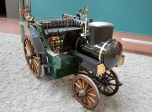Cars from 1878 to 1920 - The forerunners
Benz Victoria
1893
Code 1501
Body style: vis-à-vis carriage
Engine no. 55
Top speed: 18 kph (11 mph)
Karl Benz and Gottlieb Daimler brought the automobile to Germany. Benz’s first vehicle was driven in Mannheim on 3 July 1886, just two years after the tests run by Frenchman Delamare-Deboutteville. Right from his earliest experiments, Benz was a firm believer in the future of the automobile. By 1890, he was ready to market a few prototypes and regular production started in 1893. It is too early to talk about series-production, but two types of automobile were produced – a lightweight model called the “Velo” and a heavier vehicle offering comfortable travel for two people, the “Victoria”. Unlike the slender Velo, the Victoria was a sturdy machine.
Just like many trailblazing inventors, Karl Benz was an iconoclast. This mould-breaking approach led him to add his own design of a single-cylinder 1700 cc engine to the Victoria-style carriage. After some early difficulties and failures, this proved to be a an excellent decision, since the horizontal, rear-mounted engine enabled vibrations to be absorbed by the structure of the vehicle, an adaptation of one of the most flexible and comfortable contemporary horse-drawn carriage models.
Because of their solid design, Victorias were exported to many different countries, and users often customised them. The very first buyer, an Austrian Baron, Theodor Von Liebieg, made a 700 km (435 mile) journey without any major mechanical problems.





















